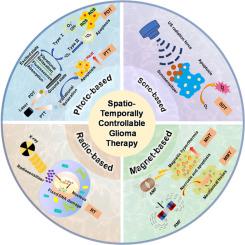Recent advances in spatio-temporally controllable systems for management of glioma
IF 10.7
1区 医学
Q1 PHARMACOLOGY & PHARMACY
引用次数: 0
Abstract
Malignant glioma remains one of the most aggressive intracranial tumors with devastating clinical outcomes despite the great advances in conventional treatment approaches, including surgery and chemotherapy. Spatio-temporally controllable approaches to glioma are now being actively investigated due to the preponderance, including spatio-temporal adjustability, minimally invasive, repetitive properties, etc. External stimuli can be readily controlled by adjusting the site and density of stimuli to exert the cytotoxic on glioma tissue and avoid undesired injury to normal tissues. It is worth noting that the removability of external stimuli allows for on-demand treatment, which effectively reduces the occurrence of side effects. In this review, we highlight recent advancements in drug delivery systems for spatio-temporally controllable treatments of glioma, focusing on the mechanisms and design principles of sensitizers utilized in these controllable therapies. Moreover, the potential challenges regarding spatio-temporally controllable therapy for glioma are also described, aiming to provide insights into future advancements in this field and their potential clinical applications.

用于治疗胶质瘤的时空可控系统的最新进展
尽管包括手术和化疗在内的传统治疗方法取得了巨大进步,但恶性胶质瘤仍然是最具侵袭性的颅内肿瘤之一,其临床结果极具破坏性。时空可控的神经胶质瘤治疗方法具有时空可调、微创、重复等优点,目前正在积极研究中。通过调整刺激的部位和密度,可以很容易地控制外部刺激,从而对胶质瘤组织产生细胞毒性,避免对正常组织造成不必要的伤害。值得注意的是,外部刺激的可移除性允许按需治疗,从而有效减少了副作用的发生。在这篇综述中,我们将重点介绍用于胶质瘤时空可控治疗的给药系统的最新进展,并着重介绍这些可控疗法中使用的敏化剂的机制和设计原理。此外,我们还介绍了胶质瘤时空可控疗法面临的潜在挑战,旨在为这一领域的未来进展及其潜在的临床应用提供见解。
本文章由计算机程序翻译,如有差异,请以英文原文为准。
求助全文
约1分钟内获得全文
求助全文
来源期刊

Asian Journal of Pharmaceutical Sciences
Pharmacology, Toxicology and Pharmaceutics-Pharmaceutical Science
CiteScore
18.30
自引率
2.90%
发文量
11
审稿时长
14 days
期刊介绍:
The Asian Journal of Pharmaceutical Sciences (AJPS) serves as the official journal of the Asian Federation for Pharmaceutical Sciences (AFPS). Recognized by the Science Citation Index Expanded (SCIE), AJPS offers a platform for the reporting of advancements, production methodologies, technologies, initiatives, and the practical application of scientific knowledge in the field of pharmaceutics. The journal covers a wide range of topics including but not limited to controlled drug release systems, drug targeting, physical pharmacy, pharmacodynamics, pharmacokinetics, pharmacogenomics, biopharmaceutics, drug and prodrug design, pharmaceutical analysis, drug stability, quality control, pharmaceutical engineering, and material sciences.
 求助内容:
求助内容: 应助结果提醒方式:
应助结果提醒方式:


